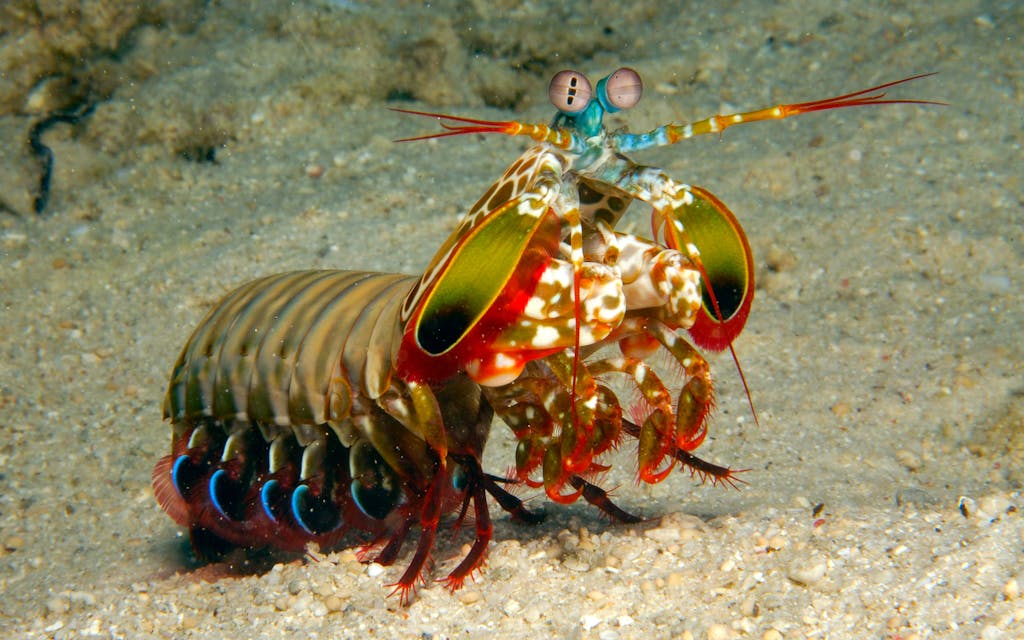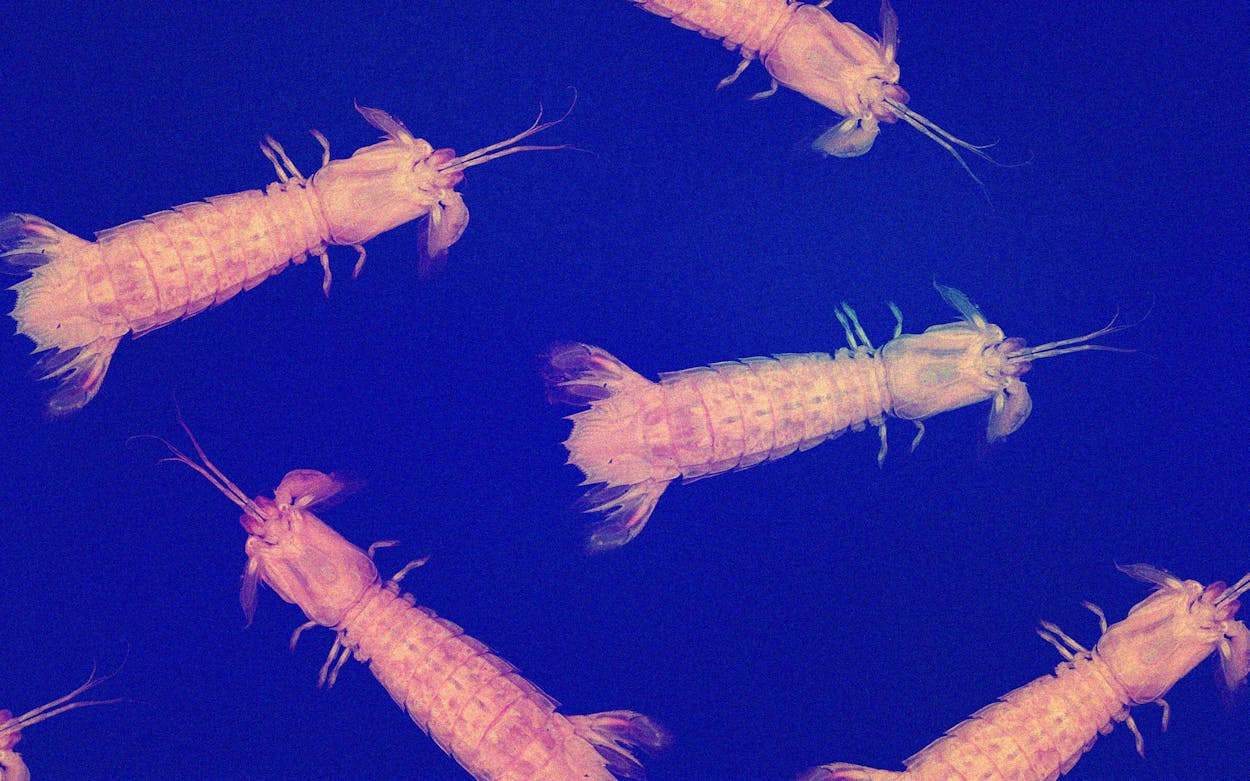Before he became a Gulf Coast fishing guide, James Sanchez endured a painful rite of passage. “I was about eleven years old, and my dad and I were fishing in Port Aransas, at one of the piers off the ship channel,” he recalls. They were casting at the height of the fall flounder and bull redfish runs, using shrimp for bait. Sanchez reached down into the bait bucket, “and I felt something kick hard against my hand.” He recoiled in pain, thinking, “Man, that was a big shrimp!”
Sanchez had encountered one of Texas’s fiercest invertebrates, the mantis shrimp (which, confusingly, is neither a mantis nor a shrimp). The many Texans who use the predatory crustacean as live bait know it by another name: the thumb splitter.
An ever-curious kid, Sanchez wrapped his hand in a towel for protection, reached back down, and grasped his attacker by the tail. “You could see its little claws flicking out at me,” Sanchez says. “I was like, ‘Holy . . . That’s really cool!’ ”
“They kind of, like, karate chop,” explains Paul Montagna, a research scientist at Texas A&M–Corpus Christi. Instead of pinching claws like those of crabs or crawdads, mantis shrimp often have calcium carbonate–hardened spears. (Some species of mantis shrimp have clubs instead, though we mostly have spearers here in Texas.) These weapons pack a powerful punch. Many mantis shrimp can fling their articulated arms out with the force of a .22-caliber rifle. Their strike has been known to break aquarium glass. The name, of course, comes from the shrimp’s similarity in appearance to its fellow invertebrate, the praying mantis.
Montagna has dedicated his academic career to understanding estuaries and the creatures that inhabit them. He explains that about 400 to 500 species of mantis shrimp exist globally—a relatively small number by crustacean standards. The predatory nature of the mantis shrimp is unusual, Montagna says, as most crustaceans prefer to scavenge.
Mantis shrimp, meanwhile, are ambush attackers. They burrow down into holes and wait for unsuspecting prey to float past. Then they stun the prey with a single strike. Recalling one of his first encounters with mantis shrimp, Montagna describes an underwater cemetery, with tiny corpses piled up left and right. “I was scuba diving in the bays, and coming across one of their little burrows, it’s just surrounded by all kinds of dead animals, other shrimps, crabs, even fish.” According to Montagna, mantis shrimp “can actually slash their little spear around like a sword.”
Anglers who use mantis shrimp to hook fish sometimes suffer small cuts on the tips of their thumbs, thus the “thumb splitter” nickname. I asked Sanchez, who also teaches seventh-grade science in Corpus Christi, why anyone dares to fish with such a feisty animal. After all, there’s no shortage of live bait that won’t hurt you.
He says it’s worth the risk. “The biggest thing is, they’re real popular for black drum, especially during the black drum run, which occurs every spring,” Sanchez says. “And mantis shrimp are readily available during that time, from the shrimp boats that go up there to catch bait.” They’re considered bycatch for shrimpers, an unintended target that’s separated from the shrimp that go to market and sold to bait shops. “They have a very hard shell, or carapace, so they stay on the hook very well,” Sanchez says. “And let’s be honest—they’re a crustacean, and pretty much if you’re a crustacean, everything eats you. This one just happens to be—I mean, excuse my language—they’re the asshole of the crustacean group.”

On another childhood fishing excursion with his dad, Sanchez remembers noticing the rainbow-colored eyes of a mantis shrimp glowing in the bait bucket. Each eye possesses trinocular vision and can gauge depth and distance independently of the other. The eyes can also process something called circularly polarized light, a type of spiraling light that only mantis shrimp can see. And the mantis shrimp, amazingly, has the best color vision in the animal kingdom. While humans see color using three kinds of receptors (red, green, and blue), the mantis shrimp has as many as sixteen. It sees the world in a mind-blowing explosion of rainbow hues—which might help explain why some kinds of mantis shrimp, most famously the peacock, or harlequin, variety, are vibrantly colored.
Scientifically known as stomatopods, mantis shrimp have inspired all sorts of laboratory research. A 2015 Duke University study looked at how, over 80 million years of evolution, the various mantis shrimp species developed a variety of striking mechanisms, including barbed spears that hook their prey on contact.
The ability of the mantis shrimp to inflict punishment without also breaking its own shell fascinated engineers at the University of Southern California and the University of California, Irvine. Mimicking the latticelike structure of mantis shrimp whackers, researchers created a super tough, regenerative material that may eventually be used in construction materials or body armor.
I asked Montagna if he knew of any mantis shrimp research in Texas, but he did not. Perhaps we’re wise to leave these buggers be. “Have you ever been hit by one?” I asked. “Oh, no,” he said. “I know better.”
- More About:
- Critters
- Shrimp
- Port Aransas






